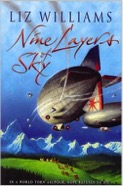
Review
Nine Layers of Sky
2003
Pan Macmillan / Tor UK
Review by Peter Young in Vector #241 (May 2005).
It has been established beyond reasonable doubt that a science fiction story is automatically improved by the inclusion of zeppelins. All science fiction writers instinctively know this, but they also know that zeppelins must never steal the show from what otherwise has to be a good story in the first place. Liz Williams appears to understand this well because Nine Layers of Sky is indeed a good, unusual and interesting story, with added zeppelins. While most of the other moving parts to this kind of mythological and science fictional fantasy are present and in full working order, I felt however that there are also one or two ingredients to this novel in smaller quantities than I would have liked.
Sometime in the 21st century Elena Irinovna, a former Soviet astrophysicist, is planning to escape Almaty and the urban wastelands of Kazakhstan and emigrate with her sister and mother to Canada. Her chance discovery of a mysterious artefact, one that can open portals to a parallel world, puts her in the sights of a mysterious group of people who require its retrieval. Ilya Muromyets, an eight hundred year old Russian living legend (a bogatyri, and currently addicted to heroin) is asked to do just that though does not bargain on the kind of journey it will be or where it will take him, physically and emotionally. Skirting the blurred edges of both our reality and the parallel world of Byelovodye are the mysterious creatures known as the rusalki, mythological sprites whose existence is more than just a Russian fable; their reputation is that of devils, though at the same time they keep Muromyets from succeeding in his long-held death wish. A strange kind of interplay between worlds is going on here, and in crossing into this parallel universe could Elena’s aspirations and dreams be stolen from her, like those of so many others?
Williams obviously has much sympathy not just for her characters but for these hard-pressed people as a whole. The greyness of post-Soviet city life is something that almost requires escape, and the breaches through reality from Earth to the parallel world of Byelovodye are not particularly welcome for those who already live there. Byelovodye itself is the Soviet dream writ large, an encapsulation of the Russian subconscious based on a functional kind of communism that so far has had the good fortune to evade confrontation with other political mindsets (well, this is escapist fiction, after all). Nine Layers of Sky is in this respect a direct blend of Soviet politics with Russian mythology, and the science fictional excursions are mostly outnumbered by the mythological ones. Hence it is something that ‘new weird’ fans would probably wish to include in their reading, though those readers may not find it quite weird enough. While there is an undercurrent that is identifiably and visibly strange – with much of the everyday scenery serving as the backdrop to the emerging drama of Elena and Ilya – it is still a gritty and realistic story and none the worse for its lesser, more everyday dramas. Williams gives much attention to the detail of Russian and Kazakh life such that the novel could also read as a kind of science fictional Lonely Planet travelogue: as putting the reader within her chosen setting is something that Williams invariably succeeds at, a small map of the central Asian territory covered here would also have been a useful addition in the endpapers.
In spite of these obvious successes it has to be said that Williams is capable of greater complexity and entanglement of her characters than is on show here. Their inner conflicts seem somehow less interactive with each other than one could expect, and Elena and Ilya are therefore less causative in the development of the plot itself (an interplay Williams has excelled at in previous novels), their fate here seeming somehow predetermined. Those zeppelins, meanwhile, arrive and depart, their function within the story, other than as a kind of visual reference point, is left open-ended.
Nine Layers is nevertheless an enjoyable and informative book, sometimes difficult to pin down and one in which the journey is possibly more important than the destination. As it stands, while clearly being self-contained it still might feel unfinished, and a sequel would certainly be worthwhile.